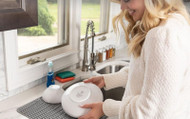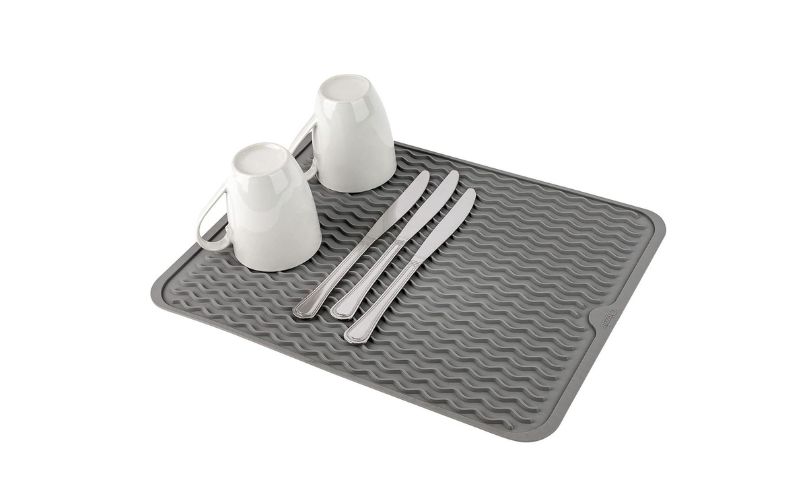How to Clean and Maintain Cooking Pans
Nov 01, 2024

When it comes to maintaining the quality of your cooking pans, you’ll want to begin by grasping the specific care each type demands. Whether you’re handling stainless steel, cast iron, or nonstick surfaces, each material requires its cleaning techniques for peak maintenance. You might think a simple wash with soap and water suffices, but that’s not always the situation. So, what’s the best way to tackle those stubborn stains or optimize your pans’ longevity without compromising their excellence? The solution is employing customized strategies that align with your cookware’s requirements.
Upgrade your kitchen with our absorbent and stylish grey Dish Drying Mat
Understanding Your Pan Material
Understanding your pan material is necessary for proper maintenance and longevity.
- Stainless steel cookware is a highly durable option that’s resistant to corrosion. These pans are versatile and able to shift smoothly from stovetop to oven. However, to guarantee they last, you must avoid harsh abrasives that could scratch their surface.
- Cast iron pans, on the other hand, require a little more care and attention. They need regular seasoning to maintain their nonstick properties and prevent rust. This seasoning process involves coating the pan with a thin layer of oil and heating it, which helps create a protective layer. This step is necessary to avoid sticky situations or even rust.
- Handling nonstick pans with care is important to preserve their delicate coating. Metal utensils or abrasive scrubbers can scratch and damage the surface. Stick to gentle, non-abrasive tools for cleaning and avoid cooking at high temperatures to prolong their lifespan.
Everyday Cleaning Techniques
When it comes to everyday cleaning methods, a simple approach often works best. For stainless steel cookware, start with hot water, a bit of dish soap, and a reliable scrub sponge. This combination usually does the trick for daily grime. Cleaner can be your best friend if you encounter any stubborn stains. Apply it to the stain, let it sit for 10 minutes, and then scrub gently for best results.
A gentle touch is essential for nonstick ceramic surfaces. Mix bakingsoda with water to tackle any marks and apply it to the stained area. Let it sit for a few minutes before giving it a good scrub. This method will help preserve the nonstick coating while keeping your pan clean.
Raw cast iron and carbon steel pans require more attention. Maintaining their seasoning layers is vital for performance. After cooking, use coarse salt and a bit of cooking oil to scrub the surface. This not only cleans but also keeps the seasoning intact. By regularly attending to your cookware, you’re ensuring its longevity and maintaining its best performance.
Handling Burnt-On Stains
While everyday cleaning keeps your pans in good shape, handling burnt-on stains requires more effort.
- Start by addressing these stubborn stains promptly to prevent them from setting in.
- Bring water and vinegar to a boil in a pan for stainless steel, copper, orenamelware pans. Once the mixture has cooled slightly, sprinkle baking soda into it for extra cleaning power. This combination effectively lifts those pesky burnt-on stains.
- You might need to scrub vigorously for extra-tough marks. This works wonders on various types of cookware, making the scrubbing process easier and more effective.
- Opt for a gentler approach when dealing with burnt-on stains in cast-iron or nonstick pans. Mix salt or baking soda with water to create a paste, and gently scrub the surface. This method is effective without damaging the pan’s surface. Remember to season cast-iron pans regularly to maintain their nonstick quality and minimize the risk of future stubborn stains. These steps will keep your pans in top condition, ready for your next culinary adventure.
Tips for Cast Iron Care
To keep your cast iron pan in top condition, season it regularly with oil to maintain its nonstick surface and fend off rust. Always hand wash it with hot water and mild soap, steering clear of the dishwasher to protect its finish. After cleaning, dry it thoroughly and apply a thin vegetable oil layer to keep it well-protected.
Season and Protect the Surface
How do you maintain your cast iron pans in top condition? The key is to season and protect the surface.
- Start by applying a thin layer of oil to your pan and heating it until the oil reaches its smoke point. This process creates a natural nonstick surface and helps prevent rusting. Regularly re-seasoning your cast iron cookware is essential for preserving its protective layer and improving the flavor of your dishes.
- After each use, avoid using soap, as it can strip away the seasoning you’ve worked hard to build. Instead, simply rinse your pan with warm water and a stiff brush.
- Once clean, dry it thoroughly to prevent rust formation. You can even place it on a stovetop burner for a few minutes to ensure it’s completely dry.
- Proper storage is just as important. Store your cast iron in a dry place to avoid moisture damage, which can compromise the seasoning. By following these steps, you’ll keep your cast iron in great shape, ensuring it lasts for generations and continues to deliver delicious, evenly cooked meals every time.
Avoid Dishwasher Use
A dishwasher might appear convenient, but it’s unsuitable for your cast iron cookware. The high heat and harsh detergents used in dishwashers can strip away the seasoning, the protective layer that makes your cast iron nonstick and rust-resistant. To keep your cookware in top condition, hand wash it instead.
- When cleaning your cast iron pans, use hot water, mild soap, and a scrubbing brush. This method effectively removes food residues without damaging the seasoning. Avoid using the dishwasher entirely, as even a single wash can lead to rust formation and compromise the pan’s surface.
- After washing, it’s essential to dry thoroughly. Any remaining moisture can cause rust, so use a towel to remove water and, if possible, heat the pan slightly on the stove to ensure it’s completely dry.
- Oil and season your cast iron cookware regularly to maintain its nonstick properties and protect it from rust. This simple routine will keep your pans performing well for years. Remember, avoiding the dishwasher and taking the time to hand wash and dry thoroughly will preserve your cast iron’s quality and longevity.
Maintaining Nonstick Surfaces
Your choice of utensils matters when it comes to maintaining nonstick surfaces; opt for wood or silicone to avoid scratching the coating. Hand wash your pans with a soft sponge and mild dish soap to keep them in great shape. Avoid stacking them without protection to guarantee they stay scratch-free and preserve their nonstick properties.
Choosing Utensils Wisely
Selecting the right utensils is crucial for maintaining the integrity of your nonstick cookware. Nonstick surfaces are designed to provide a smooth cooking experience, but using metal utensils can quickly compromise this. Metal utensils can scratch and damage the delicate coating, leading to peeling and reduced nonstick effectiveness. To keep your pans in top shape, avoid metal utensils entirely.
- Instead, opt for tools that are gentle on nonstick surfaces. Wooden spoons and soft silicone spatulas are excellent choices, as they’re less likely to scratch or damage the coating. These utensils help prolong the lifespan of your cookware, ensuring it stays nonstick and enjoyable to use.
- Minimize the use of any utensil on nonstick surfaces whenever possible. For instance, try plating food directly from the pan instead of using additional tools that might damage the surface.
- When you must use a utensil, make sure it’s designed for nonstick cookware. By choosing the right utensils, you can prioritize the care of your nonstick pans and enjoy a smooth cooking experience for years to come. Remember, caution goes a long way in preserving your kitchen investments.
Proper Cleaning Techniques
Maintaining the pristine condition of your nonstick cookware begins with the right cleaning techniques.
- Always hand wash your pans using hot, soapy water and a soft sponge to keep the nonstick coating intact. This gentle approach helps prevent scratches that can compromise the nonstick surface.
- Avoid abrasive cleaners at all costs, as they can quickly deteriorate the coating, reducing the lifespan of your cookware. Also, steer clear of metal utensils during cooking and cleaning; they’re notorious for causing damage.
- After washing, it is a good practice to apply a thin layer of neutral cooking oil. This step helps maintain the nonstick properties, ensuring that your food continues to slide off effortlessly.
- Once cleaned and oiled, thoroughlydry your pans before storing them. Proper drying prevents moisture buildup, which can lead to rust or mold. When stacking your nonstick cookware, place a paper towel between each pan. This simple barrier prevents scratching and keeps surfaces smooth.
Caring for Metal Cookware
Taking care of your metal cookware is essential to ensure it lasts for years and performs at its best.
- Begin by washing your aluminum cookware regularly right after use. This quick action prevents pitting and keeps it looking new.
- For those stubborn spots, avoid using steel wool, as it can damage the surface. Instead, use a softer scrubber. Nonstick pans demand special attention to preserve their nonstick finish. Skip the dishwasher and hand wash with a plastic scrubber to gently remove any burnt-on food without compromising the coating.
- Cast iron pans are slightly different; they need seasoning before use to develop a natural nonstick surface. Wash them with hot water and a bit of dish soap, then dry thoroughly to prevent rusting.
- Meanwhile, copper pots should be hand-washed with warm water and dishwashing liquid to maintain the tin lining. Be gentle to avoid scratching the surface.
- Enamel cookware offers some flexibility since you can either hand wash it or put it in the dishwasher. However, to keep the finish intact, steer clear of abrasive cleaners. Following these steps will maintain your metal cookware’s longevity and efficiency.
Proper Storage Practices
Once you’ve mastered caring for your metal cookware, knowing how to store it properly is equally important. Storing your cookware in a dry, well-ventilated area is essential to prevent rust and mold growth. Moist environments can quickly damage your pots and pans, so keep your storage area dry.
- Stack pans with pot protectors or even simple towels between them to avoid scratches. These act as a barrier, preserving the finish of your cookware.
- If you’re short on storage space, consider using a pot rack. Hanging your pans saves space and prevents the damage caused by stacking them on top of each other. This method benefits delicate cookware that might warp or scratch under heavy weights.
- Lids can be tricky to store alongside pots and pans. It’s a good idea to store them separately to avoid scratching the interior surfaces of your cookware. This simple step can extend the life of your pans.
- Also, be mindful not to stack heavy items on your more fragile cookware to prevent any unwanted warping or damage. By following these practices, your cookware will stay in great shape for years.
Conclusion
To keep your cooking pans in top shape, it’s important to recognize and treat each material appropriately. Use gentle cleaning methods daily and tackle tough stains with the right products. Season your cast iron regularly, and be mindful of maintaining nonstick surfaces. For metal cookware, follow specific care tips and store your pans properly. Doing so guarantees their longevity and performance, making every cooking experience enjoyable and hassle-free.

